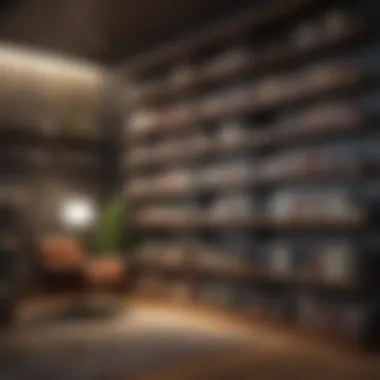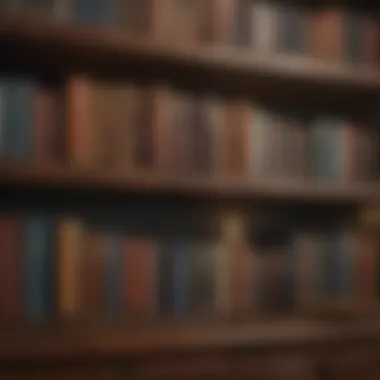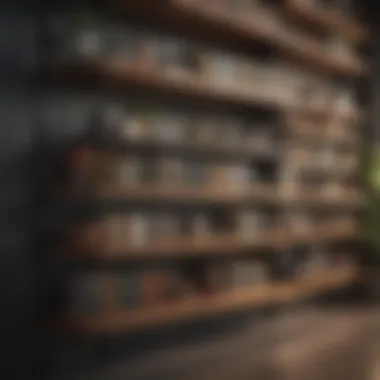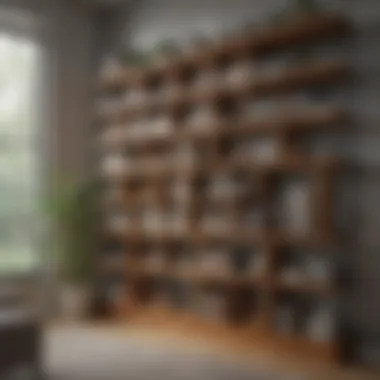Designer Bookshelves: Functionality Meets Aesthetics


Intro
In contemporary design, the significance of bookshelves goes beyond mere functionality. They embody much more than simple storage units for books. In this article, we will explore the innovative aspects of designer bookshelves, focusing on their dual role as both functional furniture and artwork within interior spaces. The evolution of design trends, choice of materials, and psychological impact are essential components we will consider, allowing readers to understand how these elements bring harmony to a home.
Bookshelves serve as focal points in living spaces. They not only hold literature but also showcase personality and style. Choosing the right bookshelf involves decisions about size, material, and aesthetics, all of which reflect personal taste. Throughout this exploration, the delicate balance between utility and artistic expression will be prioritized. Some bookshelves prioritize adaptability, while others emphasize form. Knowing how to select and maintain these pieces is crucial for anyone looking to enhance their home decor.
Furthermore, we will touch upon trends shaped by sustainability and modular design. As preferences shift towards more mindful living, the role of bookshelves in promoting organized, aesthetically pleasing spaces becomes paramount. By the end of this article, you'll possess a comprehensive understanding of the various dimensions that inform designer bookshelves, making them valuable assets in any interior design scheme.
Intro to Designer Bookshelves
Bookshelves serve more than just a practical function; they also represent an essential component of interior design. Their role goes beyond mere storage, impacting the aesthetics and organization of spaces. In exploring designer bookshelves, one recognizes the blend of utility and art, which can enhance a room’s character and feel. This article aims to spotlight these unique elements, assessing how thoughtfully designed bookshelves contribute to the overall ambience and functionality of diverse environments.
Definition and Purpose
A designer bookshelf can be defined as a functional furniture piece specifically crafted to not only store books but also to provide an aesthetic appeal. Their purpose is twofold: they organize books and personal items effectively while complementing the existing decor. Many contemporary designs prioritize modularity and can adapt to various spaces, a feature that enhances their practical use. By understanding their definitions and intended functions, homeowners can select bookshelves that meet their unique needs.
The Role in Interior Design
Bookshelves have a significant role in the broader field of interior design. They are often focal points within a room, drawing the eye and creating interest. A well-placed bookshelf can transform a dull corner into a lively area. Furthermore, they help create a cohesive style, bridging diverse design elements together.
Additionally, bookshelves can serve various functions such as:
- Display: Showcasing decorative items enhances visual appeal.
- Dividers: In open spaces, bookshelves can act as subtle partitions, delineating areas without blocking light.
- Organization: Keeping space orderly and reducing clutter plays a vital role in maintaining functionality.
Thus, in the realm of interior design, bookshelves are indispensable. They are not just storage components, but also reflections of personal style, contributing to the overall harmony of a space.
"A designer bookshelf reflects not just utility but also the artistry behind form and function."
Understanding these roles can aid design enthusiasts and homeowners in making informed choices when selecting or building designer bookshelves.
Historical Overview
The historical overview of designer bookshelves provides essential context to their modern significance. An understanding of where these furnishings originated highlights how they have become integral to both functionality and aesthetic appeal in contemporary interior design. This section explores the journey of bookshelves from practical storage solutions to multifunctional art pieces, revealing their evolution alongside societal changes and technological advancements. By analyzing their history, we can better appreciate the contemporary innovations that shape stylish and useful bookshelves today.
Origin of Bookshelves
Bookshelves have a rich history, tracing back to ancient civilizations. The earliest forms of bookshelves were simple ledges or platforms that held scrolls. In ancient Egypt, papyrus scrolls were housed in small compartments. These storage solutions were practical, mainly focusing on preserving knowledge rather than aesthetics.
During the Middle Ages, books became more common due to the invention of the printing press. By then, bookshelves evolved into crafted structures. Libraries, both public and private, began to emerge, leading to the construction of large, ornate bookshelves made from durable wood. The Renaissance period saw a significant transformation, with bookshelves becoming not just functional but also an expression of wealth, culture, and intellect.
The concept of a dedicated bookshelf became widespread in the 18th and 19th centuries. Designers began prioritizing aesthetics alongside function, creating more elaborate and decorative models. Antique styles and intricate woodwork became highly sought after, marking this period as a significant chapter in the historical journey of bookshelves.
Evolution Through Ages
As society progressed, so did the design of bookshelves. The Industrial Revolution introduced mass production, which led to newer materials and design possibilities. No longer confined to wood, materials like metals and glass began to be incorporated into bookshelves, which echoed the changing tastes of a broader consumer base.
In the mid-20th century, the minimalist movement emerged, encouraging simplicity over extravagance. The once elaborate bookshelves transformed into sleek, unobtrusive designs, aligning with modern aesthetics that favored clean lines and functionality.
The latter part of the 20th century brought about modular designs, reflecting a growing need for versatility in small living spaces. Homeowners began prioritizing space optimization, and bookshelves adapted by offering modular or customizable options that catered to specific needs.
Today, sustainable materials are being integrated into bookshelf designs, responding to an increasing awareness of environmental impact. Innovations in technology also influence new designs, with smart shelves and integrated lighting gaining popularity. The evolution through these various ages illustrates how bookshelves have continually adapted to meet the needs and tastes of society, reinforcing their role as critical components of both functionality and style in the home.


Materials Used in Designer Bookshelves
The choice of materials in designer bookshelves is fundamental to their function and aesthetic value. Each material brings its unique character, influencing not only the look of the bookshelf but also its durability and functionality. As interior design evolves, so does the use of varied materials, reflecting a balance between innovation, sustainability, and traditional craftsmanship. The materials selected for bookshelves can significantly affect space utilization and the overall atmosphere of a room.
Wood Variants
Wood is perhaps the most traditional material used in bookshelf construction. Different types of wood impart various characteristics. For example, oak offers strength and a classic look, while walnut provides rich hues and fine grain patterns. The finishing of the wood can also influence its appearance and feel. However, it is vital to consider the source of the wood. Sustainable sourcing practices are crucial to minimizing environmental impact.
- Strength and Weight: Solid wood bookshelves are often heavier but provide a solid structure.
- Maintenance: They require regular treatment to keep the finish looking good and to ensure longevity.
- Versatility: Wood can be customized easily; it adapts well to various styles, from rustic to modern.
Metals and Their Aesthetic Appeal
Metal bookshelves are gaining popularity due to their sleek design and modern appeal. Materials like stainless steel and aluminum are commonly used. Metal is highly durable and can support heavier loads compared to wood. It allows for a minimalist design that complements contemporary interiors.
- Durability: Metals resist wear and tear well, making them suitable for heavy books or decor items.
- Finish Options: Varied finishing options, such as brushed, polished, or matte, allow personalization.
- Integration: They blend effortlessly into industrial designs, enhancing urban aesthetics.
Glass and Transparency in Design
Glass shelves bring a sense of lightness and openness to a space. This material not only supports items but also provides visual continuity, making spaces appear larger. It is often used in combination with other materials. Clear glass gives a modern, airy feel, while frosted glass adds a touch of softness.
- Visibility: Glass allows for the display of books and items while maintaining a clean look.
- Cleaning: Regular maintenance is needed, as glass can show fingerprints and dust easily.
- Framing Options: Glass can be framed with wood or metal to enhance stability and design coherence.
Sustainable Materials
In recent years, the awareness of environmental issues has driven a shift toward sustainable materials. Bamboo, reclaimed wood, and composite materials are becoming more popular. These materials often have lower environmental impact compared to traditional materials. Utilizing them can reflect a homeowner's commitment to sustainability.
- Bamboo: Fast-growing and renewable, bamboo is a strong choice for eco-conscious consumers.
- Reclaimed Wood: This material offers uniqueness; each piece tells a story and adds character.
- Composites: Engineered materials can offer a balance between aesthetics, durability, and sustainability.
"Choosing the right materials for bookshelves goes beyond aesthetics; it is a reflection of values, sustainability, and a personal commitment to design integrity."
The materials used in designer bookshelves not only determine their appearance but also contribute to the overall functionality and longevity of these pieces. Each choice has implications regarding maintenance, aesthetic appeal, and environmental impact.
Design Trends in Bookshelves
The design of bookshelves reflects current trends in interior design. It is essential to understand how these trends shape both functionality and aesthetics. With more people focusing on creating personal spaces at home, designer bookshelves serve as more than mere storage. They are now art pieces that communicate individual style and taste. Moreover, trends evolve, influencing what materials and styles homeowners choose.
A well-designed bookshelf can enhance a room's overall look and feel. For many, bookshelves offer a means to showcase not just books but also decorative objects. Choosing the right design can create a focal point within any space, thereby enhancing its visual appeal. Knowing these trends helps buyers make informed decisions that align with their specific décor goals.
Minimalism and Modern Aesthetics
Minimalism is prominent in many contemporary spaces. It revolves around simplicity, clean lines, and functionality. A minimalist bookshelf often features an unobtrusive design that seamlessly integrates into a room. Wood, metal, or a combination of both is commonly used, with the focus on neutral colors. The objective is to declutter and promote an open feeling.
This approach not only prioritizes function but also embodies a philosophy of less is more. An efficient minimalist bookshelf keeps only the essentials, promoting organization. Furthermore, open shelving without doors engages with the surrounding environment, allowing art pieces and plants to enhance the aesthetic appeal. The minimalist trend is especially appealing to those who appreciate an uncluttered, serene atmosphere.
Eclectic and Artistic Arrangements
The eclectic bookshelf embraces individuality and creativity. This trend breaks free from uniformity, allowing diverse styles and materials to coexist. A mix of vintage finds, new pieces, and handmade items often characterize these bookshelves. Homeowners may choose to display books with various orientations or intersperse objects like sculptures or decorative figurines.
Artistic arrangements allow for personal expression. The power of color and texture comes into play, offering a vibrant contrast to traditional designs. Creative layouts can transform ordinary bookshelves into a narrative of personality and taste. This trend speaks especially to those who aim to showcase their life’s collections, making the bookshelf a conversation starter in any room.
Modular Systems


Modularity symbolizes the future of bookshelf design. These systems are versatile, allowing homeowners to configure their setups according to changing needs. Modular bookshelves can be expanded, reconfigured, or adapted easily, catering to evolving preferences.
Whether for a growing collection or a seamless fit in a new space, these systems maximize storage potential. They offer the flexibility to adapt to various room layouts and styles. This makes modular systems ideal for urban living, where space is often at a premium. Additionally, the variety of styles ensures that even a modular setup can align with one’s aesthetic vision.
"The adaptability of modular bookshelves provides a solution for both style and practicality."
Understanding these trends helps homeowners create spaces that reflect their personal style while meeting practical needs. The interaction between modern aesthetics, creative expression, and modular functionality defines the evolution of designer bookshelves.
Functional Aspects of Designer Bookshelves
The functional aspects of designer bookshelves play a crucial role in their selection and placement within living spaces. Homeowners and design enthusiasts often seek to balance utility with beauty, ensuring that their choice of bookshelf does not merely serve as storage but also enhances the overall aesthetic of the room. Understanding the functional elements of these shelves can lead to more informed decisions that satisfy both practical needs and design preferences.
Storage Solutions
One of the primary functions of designer bookshelves is their capacity to store books, decor, and personal items effectively.
- Material and Structure: Different materials, such as solid wood, metal, or glass, can influence the weight capacity and durability of the shelves. It's essential to choose a material that meets the storage requirements while aligning with the intended design aesthetic.
- Design Features: Features like adjustable shelves allow for flexibility in storing various items, from oversized coffee table books to decorative boxes. Incorporating enclosed cabinets or drawers can also help minimize clutter and provide discreet storage options.
- Specialty Shelving: Some bookshelves come with integrated lighting or unique compartments that showcase items while providing storage. These practical enhancements can turn a simple bookshelf into a statement piece.
Space Optimization
Space optimization is another vital aspect of designer bookshelves, especially in smaller homes or apartments. Choosing the right bookshelf can significantly impact efficiency and organization within a room.
- Vertical vs. Horizontal Design: Vertical bookshelves make use of vertical space, drawing the eye upward and creating an illusion of height in a room. On the other hand, horizontal arrangements can serve as a low-profile solution that doubles as a display or seating area.
- Modular Options: Many modern designer bookshelves offer modular units that can be rearranged or expanded to fit changing space needs. This adaptability is critical for homeowners who prioritize both function and style.
- Corner Shelves: Corner bookshelves utilize typically wasted space in a room. These shelves can help create a cozy reading nook while maximizing storage potential.
In summary, thoughtfully designed bookshelves not only offer practical storage solutions but also play an essential role in optimizing space. Their design impacts both the functionality and visual appeal of a room, making them a pivotal choice in interior design.
Installation Considerations
The installation of designer bookshelves plays a crucial role in maximizing their functionality and appearance within a space. Choosing how to mount or position a bookshelf affects not only the aesthetics but also the practicality of the unit. Failing to account for installation needs can lead to a dissatisfied homeowner, unintentional damage to property, or even safety hazards. Thus, an understanding of the installation considerations is vital for anyone looking into acquiring a designer bookshelf.
Wall-Mounted vs. Freestanding
The choice between wall-mounted and freestanding bookshelves significantly influences available floor space and overall room design. Wall-mounted bookshelves can create the illusion of a larger area. They take up minimal ground space while still providing ample storage. These shelves can also draw the eye upward, enhancing the verticality of a room. On the other hand, freestanding bookshelves offer flexibility. They can be relocated easily to adapt to changing layouts or styles in interior design.
When assessing your personal style and space constraints, consider the following:
- Room Dimensions: Wall-mounted shelves can optimize small spaces. Freestanding units may be more suitable for larger areas with more furniture.
- Personal Preference: Some prefer the lightness of wall-mounted options as they can keep floors clear. Others may enjoy the prominent presence of freestanding bookshelves.
- Accessibility: Freestanding bookshelves typically allow easier access to books and decor elements, while wall-mounted shelves may require a step stool for upper levels.
Safety and Stability Concerns
Ensuring safety and stability is a non-negotiable aspect of installing designer bookshelves. This topic gains importance especially in homes with children or pets. Wall-mounted bookshelves must be secured properly to avoid accidents caused by tilting or falling. Using appropriate anchors, like toggle bolts or wall studs, can significantly increase stability.
For freestanding bookshelves, it is essential to ensure that the bookshelf is not top-heavy. The following points should be evaluated:
- Weight Distribution: Heavy books should ideally be placed on lower shelves to maintain a low center of gravity.
- Anchoring Options: Consider using furniture anchors to secure taller units against walls, diminishing the risk of tipping over.
- Regular Checks: Perform routine assessments of the bookshelves to ensure that all screws, bolts, and fixtures remain secure over time.
"Proper installation ensures not only the beauty of designer bookshelves but also the safety of all who occupy the space."
By carefully considering these installation factors, homeowners and design enthusiasts ensure that their selected designer bookshelves fulfill their intended purpose, enhancing both functionality and aesthetic appeal.
Psychological Effects of Organized Spaces


The organization of physical spaces, especially in the context of designer bookshelves, plays a pivotal role in influencing psychological well-being. This section delves into how well-arranged spaces contribute to greater productivity and emotional stability. The connection between environment and mental state is not merely coincidental; it is woven deeply into our daily experiences and habits.
Impact on Productivity
Organized spaces significantly enhance productivity levels. The presence of a well-structured bookshelf can facilitate focus and efficiency. When items are stored methodically, it becomes easier to locate resources quickly. This direct access minimizes distractions.
Key factors in this productivity boost include:
- Reduced Clutter: Cluttered spaces create overwhelming feelings. An organized bookshelf reduces visual chaos, leading to a clearer mind.
- Structured Environment: A designated space for books or materials fosters a routine. This routine reinforces discipline and enhances concentration.
- Aesthetic Appeal: Visually appealing design can inspire creativity. The beauty of a designer bookshelf can motivate one to engage with literature or projects more actively.
Research suggests that well-organized environments result in improved cognitive function. This highlights the need for thoughtfully designed bookshelves not simply as decoration but as integral tools for personal and professional development.
Emotional Benefits of Order
The emotional benefits of maintaining organized spaces are profound. When one's environment is orderly, it promotes feelings of control, calmness, and contentment.
Consider the following emotional advantages:
- Sense of Accomplishment: Organizing books on a shelf can provide a sense of achievement. Completing this task may encourage individuals to tackle more significant responsibilities.
- Reduction in Stress: Studies show that clutter can lead to increased stress levels. An orderly bookshelf can provide a sanctuary, allowing the mind to rest.
- Enhanced Mood: Clarity in physical spaces often translates to clarity in mental states. A clean and organized bookshelf contributes to a positive atmosphere, which can uplift spirits.
"An organized environment brings a sense of peace. It allows the mind to focus on creativity and self-expression, rather than chaos."
In sum, the effects of organized spaces, specifically through designer bookshelves, are not just about utility. They also impact emotional and psychological states significantly. Homeowners, interior design enthusiasts, and others benefit from understanding these influences by choosing and maintaining their spaces with care. An environment that harmonizes functionality with aesthetic appeal ultimately supports a more balanced and fulfilling life.
Care and Maintenance
Care and maintenance play a crucial role in preserving the aesthetic and functional qualities of designer bookshelves. Understanding these elements ensures that the investment in your shelves remains valuable over time. Regular maintenance not only prolongs the lifespan of the materials used but also maintains the visual appeal of your shelving unit.
Cleaning Techniques
Effective cleaning techniques are essential to preserve the beauty of designer bookshelves. Here are some approaches to consider:
- Dusting: Use a soft, lint-free cloth to remove dust particles. This prevents the accumulation of grime that can dull the surface of wood or metal.
- Gentle Cleaning Solutions: For wooden surfaces, consider a mild soap and water solution. Wipe with a damp cloth, then dry immediately to prevent water damage.
- Specialized Cleaners: For glass shelves, a glass cleaner works well. Ensure that it is streak-free for a polished finish.
- Avoid Harsh Chemicals: Do not use harsh abrasive cleaners or chemical solvents, as they can damage finishes or structural integrity.
Preventing Damage
Preventive measures are necessary to avoid potential harm to your designer bookshelves. Some key strategies include:
- Weight Distribution: Ensure books and items are evenly distributed across shelves. This prevents warping and structural issues.
- Avoiding Direct Sunlight: Position your bookshelves away from direct sunlight to avoid fading of colors and finishes.
- Humidity Control: Maintain a stable humidity level in your space. Wood can expand and contract with changes in moisture, leading to cracks and deformation.
- Regular Inspections: Periodically check your bookshelves for any signs of wear or damage. Early detection allows for prompt repairs, preserving the integrity of your shelves.
Maintaining your designer bookshelf is as vital as selecting the right one. Proper care enhances both functionality and aesthetic appeal, ensuring longevity.
By implementing these cleaning techniques and prevention strategies, homeowners can keep their designer bookshelves looking fresh and functioning well. Understanding care and maintenance extends the lifespan of these pieces, amplifying their role as both decorative and practical elements in home decor.
Culmination
The conclusion serves as an essential component in any comprehensive examination of designer bookshelves. It brings together key insights and provides a concise reflection on the learned material. In this article, we explored various aspects, including functionality, aesthetic appeal, and the innovations in bookshelf design. This not only underscores the importance of bookshelves in home décor but also highlights their dual role as functional furniture and artistic expression.
Summary of Key Points
- Definition and Role: Designer bookshelves encompass both a practical storage function and a crucial element of interior design.
- Historical Context: Understanding the evolution of bookshelves assists in appreciating the modern designs available today.
- Material Choices: The choice of materials plays a significant role in the durability, feel, and overall aesthetics of bookshelves, including wood, metal, glass, and sustainable options.
- Design Trends: Current trends like minimalism, eclectic arrangements, and modular systems demonstrate the diversity in modern bookshelf designs.
- Functional Aspects: Effective storage solutions and space optimization strategies are critical for maximizing utility in smaller spaces.
- Installation Considerations: Careful planning in choosing between wall-mounted or freestanding designs ensures both safety and appropriate use of space.
- Psychological Effects: Organized spaces enhance productivity and emotional well-being, connecting the physical arrangements of bookshelves with personal benefit.
- Care and Maintenance: Strategies for cleaning and preventing damage prolong the life and integrity of designer bookshelves.
Future Trends in Designer Bookshelves
As we continue to observe shifts in interior design, the future of designer bookshelves appears promising. Some anticipated trends include:
- Sustainability: The growing emphasis on eco-friendly materials will likely dominate future designs. Consumers may seek bookshelves made from reclaimed wood or recycled materials.
- Smart Furniture Integration: Inclusion of technology, such as built-in charging ports, LED lighting, or even smart speakers, will appeal to the tech-savvy homeowner.
- Customisation: Increased demand for personalized designs may lead to more companies offering customizable bookshelf solutions.
- Multifunctionality: The trend towards compact living will encourage multifaceted uses of bookshelves, such as integrating them with seating or workspace elements.
In synthesizing these insights, it becomes evident that bookshelves are much more than just storage units; they reflect personal style and adapt to changing needs. Understanding this will assist homeowners and design enthusiasts in making informed decisions, ensuring their choices resonate with both aesthetics and practicality.



